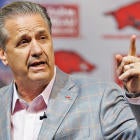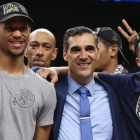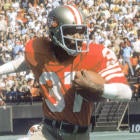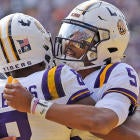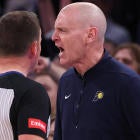I watched with much amusement last week as my friend Doug Rhoads, the ACC Supervisor of football officials, sent a good chunk of the college football world into a DEFCON 1 panic mode.
During a rules seminar for the media in Greensboro, N.C., Rhoads was giving his interpretation on the new "targeting rule," which is designed to take the cheap head shots (and the celebrations that come with them) out of the game. The rules, which call for a 15-yard penalty and an immediate ejection if warranted, have always been in place. But this season they have become "a point of emphasis," which is officials talk for "if you see it you had better call it. And if it's close, you REALLY better call it."
Now Doug was rocking along just fine, explaining how the rule was going to work: If an ejection is called on the field, the replay guy in the booth looks at it in slow motion and from several angles to determine if the ejection is warranted. The replay official has the power to overturn the ejection.
Then Doug suggested that the mega-hit by South Carolina's Jadeveon Clowney on a Michigan running back in the Outback Bowl -- a hit that was the No. 1 video on the planet for six months -- could have resulted in a penalty with an ejection.
My goodness, you would have thought the man stole Christmas. To suggest that Clowney's hit would have warranted ejection was not only wrong, went the argument, it was "Un-American."
"If they are going to throw people out for the Clowney hit," Nebraska coach Bo Pelini told George Schroeder of USA Today, "we should find another sport."
OK, let's everybody relax and take a deep breath. Feel better? Now, a couple of points:
First of all, trust me when I tell you that when everything shakes out, despite Rhoads's interpretation of the rule, the Clowney hit would not have been a penalty. One of the key components of the rule is to protect a DEFENSELESS player from having his head targeted by an opposing player. A running back with the ball, by definition, is not a defenseless player.
Look at this replay of the Clowney hit from YouTube. Go to the 51-second mark. That angle clearly shows that Clowney's helmet hits the Michigan player square in the front of the shoulder pads. The impact of the hit was so great that the helmet of the running back pops off.
Now, you want to see an example of what WILL be called for targeting? Look at this play from last season's South Carolina-UAB game. Gamecocks defensive back D.J. Swearinger goes straight for the head of a UAB receiver.
This one, as it was described to me, was a no-brainer. Swearinger was penalized but not ejected from the game. After watching the video on Sunday, the SEC office suspended him for a full game. He should have been thrown out on the spot. If that hit happens this season, the player is going to get tossed.
I think all of the fear and loathing from fans and coaches about this emphasis in the rules is a bit excessive. The game has rules in order to make it as fair and as safe as possible for the people who play it. The rules change. Players adjust and modify their behavior. Coaches make adjustments in the way they coach the position. Life goes on.
But Tony! But Tony! Some official somewhere is going to make a mistake! Some player is going to get thrown out when he shouldn't be! This rule may actually cost somebody -- GASP! -- an important game!
OK. Take another deep breath.
My response is: Yeah, that may happen. So?
The coaches know this and the fans are going to have to learn this: This emphasis on the targeting of defenseless players is just a tiny part of a much larger conversation we are having in college football.
"Our game is under attack," said Steve Shaw, the SEC's supervisor of officials.
Don't believe it? Think that is excessive? Consider this:
Writer Malcolm Gladwell (The Tipping Point) is a man of no small intellect. He has written extensively that given the violent and exploitative nature of football (his analysis, not mine), institutions of higher learning should disassociate themselves from the sport. He argues that it simply isn't safe because of the long-term effects of concussions. Watch this recent interview with Fareed Zakaria on CNN. It's about seven minutes long but interesting. He compares college football to dog fighting.
So, you're going to dismiss Gladwell as some pointy-headed intellectual who doesn't understand our game and what it means to us?
Then what about George Will, one of the leading conservative writers of our time? Will, a great lover of baseball, has concluded that football, as an institution, is broken and it can't be fixed.
I have had parents of young boys come to me and ask if it is safe for their sons to play football. I don't know what to tell them. It is a physical game. There are risks. There are no guarantees.
So here's the point. While the fans and the coaches are worried about how this emphasis on the rule might impact one team or one game or even one season, the commissioners who run the sport are looking at something totally different. They see an ongoing concussion lawsuit against the NCAA that has the potential to dwarf the Ed O'Bannon case in scope and ultimate impact.
Here is the story from USA Today about a former football player, 27, who is living on disability payments because of concussions he suffered while playing the game. Think a sympathetic jury won't look at the billions generated by college football and decide the fathers of the game didn't do their due diligence?
The piece makes the case that a class-action concussion suit against college football actually has a BETTER chance of succeeding than the one currently being waged against the NFL. Why? Because the NFL guys got paid and assumed the risk. The college guys got room, books, board and tuition.
How about this: Ryan Swope left Texas A&M after the 2012 season as the school's all-time leading receiver in yards (3,117) and receptions (252). He ran a 4.35 in 40-yard dash at the NFL combine and was drafted by the Arizona Cardinals. Last Friday, on the advice of team doctors, he retired from football because of the effects of concussions.
There are going to be more of these stories. A lot more. And that's why I'm going to leave you with this:
The fans are right when they say that this rule adjustment has the potential for some bad outcomes. The short answer is to make sure the officials get it right. But mistakes are going to be made. That's life.
But the long-term health and survival of the game demands what is a relatively minor change. In short, the fans, coaches and media had better get on board because this train is leaving the station with or without you.












